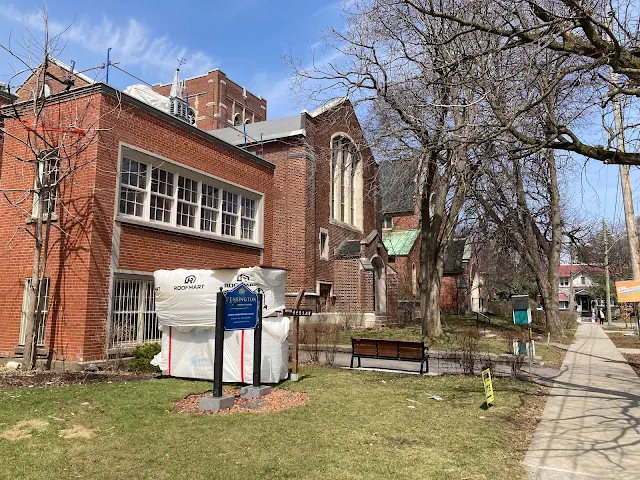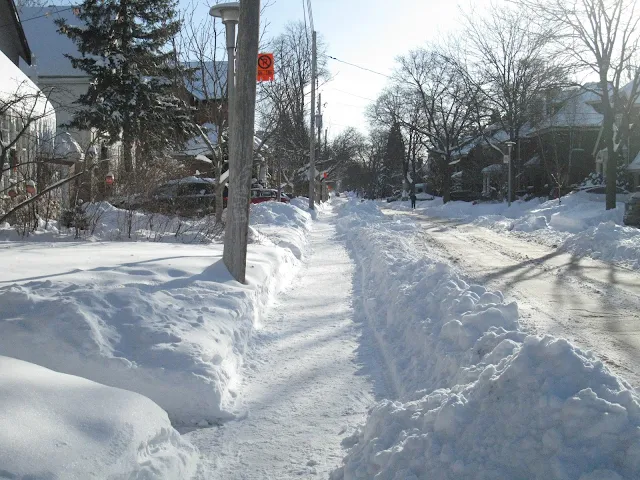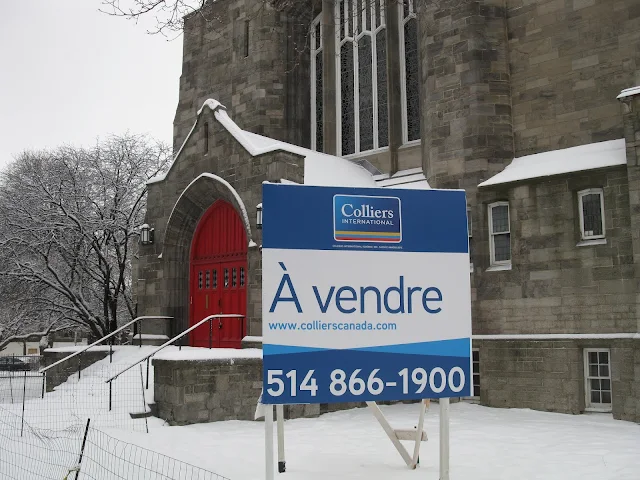 |
| L'église Notre-Dame-de-Grâce, this is approximately where Darrell Morrisey painted the church almost a century ago. |
L'église Notre-Dame-de-Grâce is located on the corner of avenue Notre-Dame-de-Grâce and Boulevard Decarie in Montreal. This is the church that Darrell Morrisey painted in the 1920s; the painting, discovered about a year ago, is on the reverse of another of her paintings, one of a hay cart in Quebec. Seeing this painting, right away, I thought there was something familiar about this church, I Googled the image of the church and found L'église Notre-Dame-de-Grâce and recognized it; I used to live at 4100 Av Northcliffe just a block from the church, I used to wait for a bus across the street from the church and then proceed to work on Montreal’s South Shore. That was from 1976 to 1979.
 |
| Written above the church entrance: "Maria gratia plena, Dominus tecum" is Latin for "Hail Mary, full of grace, the Lord is with thee." |
 |
| Darrell Morrisey's painting of L'église Notre-Dame-de-Grâce (1927-1930) |
 |
| The bell tower, on the far right, was constructed in 1927; this helps us date Darrell Morrisey's painting of the church, it is between 1927 and 1930, the year in which she died. |
 |
| The entrance to the offices of St. Augustine Catholic Church on the east side of the church, the bell tower was added in 1927. |
 |
| The offices of L'église Notre-Dame-de-Grâce are on the west side of the church. |
 |
| Note the Sulpician logo on front of church The Sulpicians have a long history in Montreal. This interests me because two of my great great uncles were educated at the Grand Séminaire de Montréal by the Sulpicians; the Sulpicians admitted into the seminary these two working class boys, Martin Callaghan, who became the first Montreal born pastor at St. Patrick's Church, and James Callaghan, a future pastor at St. Ann's Catholic Church in Griffintown; sons of immigrant Irish parents, the Sulpicians opened the doors of education, religion, and society to them. They were educated in Rome and Paris, and they were celebrated at home where they were respected and well known. While I am not deeply religious, I am interested in the churches of Montreal, churches of all faiths, and I am interested in my family history which is closely associated with the history of Montreal. The architect of L'église Notre-Dame-de-Grâce was John Ostell, interior stained glass windows are by Guido Nincheri, and the church is a part of the Sulpician history of Montreal. |
- NEWS
Last year, during the celebration of the 375th anniversary of the founding of the city of Montreal, a group of faithful Québecois devoted to the early founders came to France to trace the French heritage that first arrived in Canada in 1642.
The Sulpicians became intimately tied to the city of Montreal—then named Ville-Marie—when the Sulpician founder, M. Jean-Jacques OLIER, who was part of the founding Société de Notre-Dame de Montréal interested in establishing firm Christian roots in New France, joined in sending a contingent of French missionaries to Montreal in 1657, the year of his own death. Arriving in August 1657, the Sulpicians found the city on the verge of collapse. They immediately set about plans to stabilize and restore the city. They organized the streets, gave them names that endure to the present (such as, rue Note-Dame, rue Saint-Mathieu, rue Saint-Paul, etc.), and basically saved the city, which now survives as a thriving multicultural metropolis in Canada.
The Sulpicians consequently became known as the “lords of Montreal,” having been granted a “seigneury” by the King of France. Olier thus entered Montreal’s history, along with Paul de Chomedey de MAISONNEUVE, Jeanne MANCE and Jérôme Le Royer de la DAUVERSIÈRE, as a heroic figure of the past whose influence endures today. Only a few years ago, during renovations at the first Grand Séminaire Saint-Sulpice in Old Montreal, vestiges of the original city walls were discovered and have now been preserved for future generations.
During the summer of 2017, the Superior General, M. Ronald D. WITHERUP, PSS, welcomed a small group of pilgrims from Quebec at the Generalate in downtown Paris, where he was interviewed to comment on Olier’s incredible missionary vision and his desire to participate in the sending of missionaries to Montreal and New France. The group included Sylvie TRUDELLE, Clément FORTIN, Pierrette ROY, and Roger BÉDARD. Upon their return to Canada, they created a 36-minute video available on Facebook, which includes two short segments of the interview with Father Witherup.
Source: https://www.generalsaintsulpice.org/en/news/64-montreal-and-saint-sulpice















.JPG)
.JPG)
.JPG)
.JPG)
.JPG)
.JPG)
.JPG)
.JPG)
.JPG)
.JPG)



















